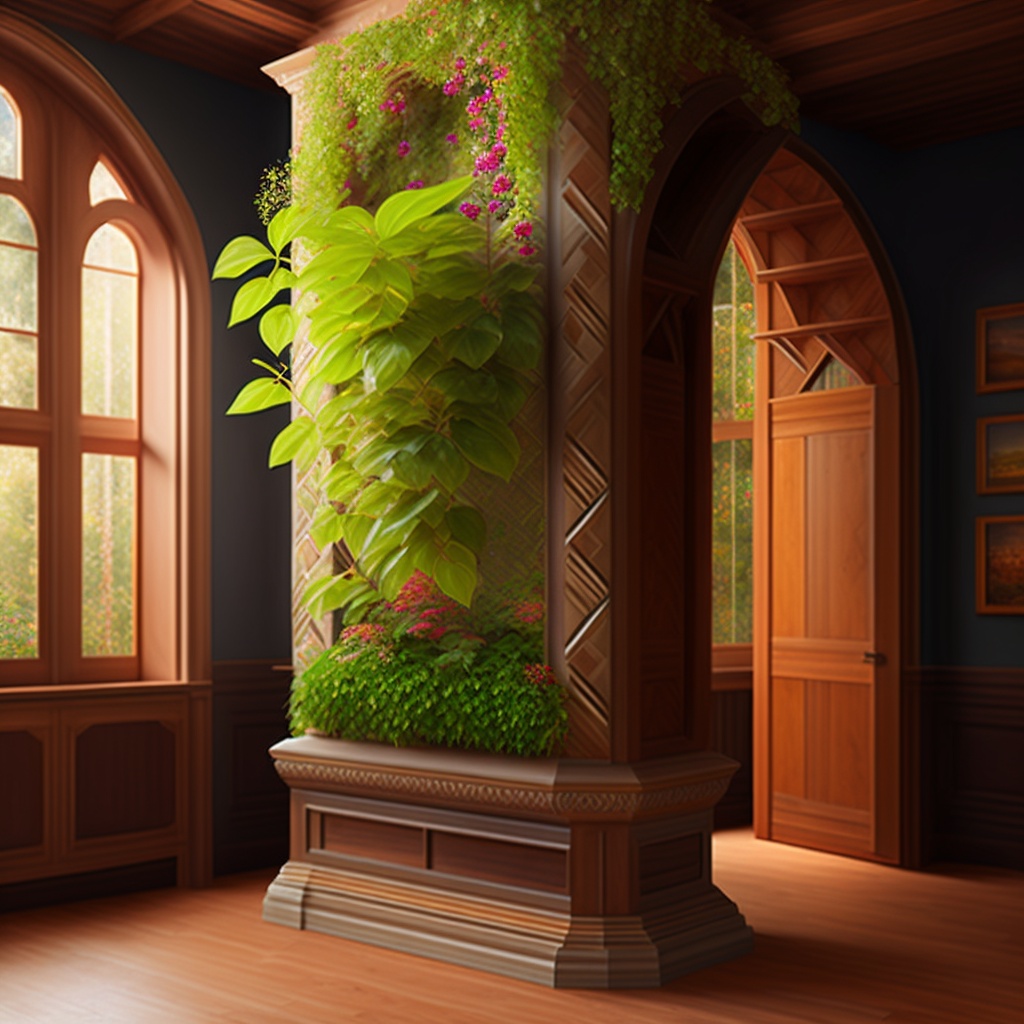Introduction
Indoor vine plants have gained immense popularity among enthusiasts due to their charming aesthetics and the sense of tranquility they bring to indoor spaces. In this article, we will delve into the world of indoor vine plants and explore why they are an excellent choice for your home. From their numerous benefits to the variety of options available, you’ll discover why they have become essential to interior design.
Why Choose Indoor Vine Plants?
Indoor vine plants offer unique characteristics that make them an ideal choice for indoor gardening enthusiasts. Let’s explore some of the reasons why you should consider incorporating them into your home decor:
Benefits of Indoor Vine Plants
Indoor vine plants provide more than just aesthetic appeal; they offer several benefits for your well-being and the atmosphere of your home. Let’s delve into the advantages of having indoor vine plants:
1. Improved Indoor Air Quality: Indoor vine plants can remove toxins from the air and release oxygen, improving the overall air quality in your home. They can effectively filter pollutants such as formaldehyde, benzene, and xylene, promoting a healthier living environment.
2. Enhanced Mood and Productivity: Research suggests that being around plants can improve mood, reduce stress, and increase productivity. They create a calming and soothing atmosphere for home offices and living areas.
3. Natural Humidifiers: Many indoor vine plants release moisture through their leaves, increasing humidity levels in dry indoor environments. This can be particularly beneficial during the winter months when central heating can cause the air to become dry.
4. Visual Interest and Décor: Indoor vine plants add a touch of natural beauty to any space. Their cascading vines, varying leaf shapes, and colors create visual interest. They can be used to decorate walls, shelves, and hanging baskets.
5. Connection with Nature: They connect to nature, even in urban environments. The presence of greenery indoors can evoke a sense of calm and tranquility, promoting overall well-being. They are also the perfect addition to your self sustaining home.
Choosing the Right Indoor Vine Plant
Selecting the perfect specimen requires careful consideration of various factors, including available space, lighting conditions, and personal preferences. Let’s explore the key aspects to keep in mind when choosing the right indoor vine plant for your home:
1. Available Space: Consider the available space in your home and determine whether you have ample room for a trailing vine or prefer a more compact variety placed on a shelf or tabletop.
2. Lighting Conditions: Assess the lighting conditions where you plan to place the indoor vine plant. Some varieties thrive in bright, indirect light, while others tolerate lower light levels.
3. Maintenance Level: Evaluate the level of care you can provide. Some indoor vine plants require more attention and care, while others are more resilient and can tolerate occasional neglect.
4. Aesthetic Appeal: Consider the visual aesthetic you want to achieve in your home. Indoor vine plants come in various shapes, sizes, and foliage colors. Choose a plant that complements your existing décor and personal style.
Popular Varieties of Indoor Vine Plants
Indoor vine plants offer various options, each with unique characteristics and growth patterns. Let’s explore some popular types of indoor vine plants:
1. Pothos (Epipremnum aureum): Pothos, also known as devil’s ivy, is one of the most popular indoor vine plants. It features heart-shaped leaves and comes in various variegated colors, such as green and golden yellow.
2. Philodendron (Philodendron spp.): Philodendrons are beloved for their lush foliage and ease of care. They come in various varieties, including the heartleaf philodendron and the trailing philodendron.
3. Hoya (Hoya spp.): Hoya plants, commonly known as wax plants, have waxy leaves and produce clusters of beautiful star-shaped flowers. They are excellent trailing plants that can add elegance to any room.
4. String of Hearts (Ceropegia woodii): The string of hearts is a delicate trailing plant with heart-shaped leaves that make it a charming addition to any hanging basket or shelf.
5. Spider Plant (Chlorophytum comosum): Spider plants have long, arching leaves with white stripes. They are known for their air-purifying properties and adaptability to various light conditions.
When selecting a specific variety, consider light requirements, growth rate, and the level of care and attention you can provide. This will help ensure a successful and enjoyable indoor gardening experience.
Lighting Requirements
Proper lighting is crucial for the growth and vitality of indoor vine plants. Most vine plants thrive in bright, indirect light conditions. Place them near a window where they can receive filtered sunlight throughout the day. However, be cautious of placing them in direct sunlight, as it can scorch the leaves.
If your space lacks sufficient natural light, you can supplement it with artificial grow lights. LED grow lights are popular as they provide the correct light spectrum for plant growth while consuming less energy. Place the grow lights a few feet above the plants and adjust the duration of light exposure based on the specific needs of your indoor vine plants.
Temperature and Humidity
Indoor vine plants generally prefer temperatures between 60°F and 80°F (15°C to 26°C). They can tolerate slightly cooler temperatures during the winter months but should be kept away from cold drafts.
Maintaining moderate humidity levels are essential for the well-being of vine plants. Suppose the air in your home is dry. In that case, you can increase humidity by using a humidifier, placing water tray near the plants, or misting their leaves regularly. Creating a humidity tray by placing pebbles in a shallow tray filled with water can also help to provide localized humidity around the plants.
Watering and Fertilizing
Proper watering is essential to prevent root rot or dehydration in indoor vine plants.It’s crucial to find the right balance and avoid overwatering or underwatering. Allow the top inch of soil to dry out between waterings and ensure proper drainage to prevent waterlogging.
The watering frequency will depend on specific vine plant species, pot size, and environmental conditions. Check the soil’s moisture level by inserting your finger into the soil up to the first knuckle. If it feels dry at that depth, it’s time to water the plant.
In addition to regular watering, indoor vine plants can benefit from periodic fertilization. Fertilizers provide essential nutrients that support healthy growth. Choose a balanced liquid fertilizer specifically formulated for indoor plants and follow the instructions on the packaging for proper dilution and application.
Pruning and Training
Regular pruning helps maintain the shape and appearance of your indoor vine plants. It also promotes healthier growth and denser foliage. Pruning can involve the removal of dead, yellowing, or damaged leaves, as well as trimming back overgrown vines to control their length and encourage bushier growth.
Make clean cuts just above a leaf node or stem junction to promote new growth when pruning. Use sharp, clean pruning shears or scissors to prevent damage or disease transmission. Remove any leggy or straggly growth to maintain a neat and compact appearance.
Training your indoor vine plants to climb or trail along trellises, stakes, or moss poles can add an interesting visual element to your space. Gently guide the vines in the desired direction and secure them using soft ties or plant clips. Regularly check the ties to ensure they are not too tight, as they can restrict growth or cause damage to the plant.
Pots and Trellises
Choosing suitable pots and trellises are crucial for indoor vine plants’ proper growth and support. Select pots with drainage holes at the bottom to prevent waterlogging and promote healthy root development. Well-draining potting soil is also vital to ensure proper aeration and moisture control.
Consider the size of the pot in relation to the mature size of the plant. A pot that is too small can restrict root growth and lead to stunted development. Conversely, a pot that is too large can hold excess moisture, increasing the risk of root rot.
If you have climbing vine plants, providing a trellis or stake will allow them to grow and expand vertically. Choose a sturdy trellis or stake that can accommodate the plant’s growth. Secure the trellis or stake firmly to prevent toppling or damage to the plant as it grows.
Common Pests and Diseases
Like any other plants, indoor vine plants can be susceptible to pests and diseases. Common pests affecting indoor vine plants include aphids, mealybugs, spider mites, and scale insects. These pests can cause damage to the leaves, weaken the plant, and even spread to other plants.
Inspect your plants regularly for any signs of pests or disease to prevent pest infestations. Look for visible insects, sticky residue on the leaves (a sign of aphids), webbing (a sign of spider mites), or yellowing and distorted leaves. If pests are detected, take immediate action to prevent them from spreading.
There are several methods to control pests on indoor vine plants. Here are a few options:
1. Manual Removal: Remove the pests by gently wiping the leaves with a damp cloth or using a soft brush to dislodge them for small infestations.
2. Insecticidal Soap: Spray the affected plant parts with an insecticidal soap solution. This will suffocate and kill the pests. Follow the instructions on the product label for proper dilution and application.
3. Neem Oil: Neem oil is an organic insecticide effective against various pests. Mix neem oil with water and apply it to the affected plant parts. Repeat the treatment every few days until the infestation is under control.
4. Biological Controls: Introduce beneficial insects that feed on pests, such as ladybugs or predatory mites. These natural predators can help keep the pest population in check.
Prevention is key when it comes to pest control. Maintain good air circulation around your plants, avoid overwatering, and regularly remove dead or decaying plant material. These practices can help reduce the risk of pests and diseases.
Decorating with Indoor Vine Plants
Indoor vine plants offer endless possibilities for creative and stylish décor. Here are some ideas for incorporating them into your living spaces:
1. Hanging Baskets: Hang trailing vine plants in decorative baskets from the ceiling for an eye-catching display.
2. Vertical Gardens: Create a vertical garden by installing a trellis or wall-mounted planters, allowing vine plants to climb and cascade.
3. Shelf Accents: Place small potted vine plants on shelves or bookcases to add a touch of greenery and create visual interest.
4. Living Wall Art: Install a living wall with a variety of vine plants for a striking and unique piece of living art.
5. Terrariums: Create a miniature indoor garden by planting vine plants in glass terrariums. The enclosed environment creates a lush and captivating display.
Experiment with different arrangements and combinations to find the style that suits your taste and complements your home decor. Remember to consider the growth habits of the vine plants and provide adequate space for them to thrive.
Propagating Indoor Vine Plants
Propagating indoor vine plants is an exciting and rewarding process that allows you to expand your collection and share the joy of gardening with others. Let’s explore a common method for propagating indoor vine plants through stem cuttings:
1. Select Healthy Cuttings: Choose a healthy vine section with at least two nodes (points where leaves emerge) and trim it just below a node.
2. Prepare the Cutting: Remove the lower leaves, leaving only a few at the top. This will prevent the cutting from rotting and encourage root development.
3. Rooting Medium: Dip the cut end of the vine cutting in a rooting hormone (optional) and plant it in a well-draining potting mix or water. Keep the soil moist but not soggy.
4. Provide Proper Care: Place the cutting in a warm location with bright, indirect light. Maintain humidity by covering the cutting with a plastic bag or using a propagation tray.
5. Monitor and Transplant: Monitor the cutting for signs of root growth, such as new leaf growth or root development visible through the potting mix. Once roots have developed, transplant the cutting into a larger pot with regular indoor vine plant care.
Propagation can be a rewarding and cost-effective way to expand your indoor vine plant
Conclusion
Indoor vine plants offer a delightful and captivating addition to any indoor space. Their cascading vines, lush foliage, and numerous benefits make them popular among plant enthusiasts. You can enjoy the beauty and benefits of indoor vine plants by choosing the right variety, providing proper care and maintenance, and incorporating them into your home decor. So, bring a touch of greenery into your home with these charming and versatile plants.
FAQs
How often should I water my indoor vine plants?
The watering frequency varies depending on the specific plant variety, environmental conditions, and potting medium. It’s generally recommended to allow the top inch of soil to dry out before watering again.
Can indoor vine plants be grown in low-light areas?
Yes, indoor vine plant varieties can tolerate low-light conditions. Examples include pothos and snake plants, which can thrive in areas with limited natural light.
Do they require fertilization?
Indoor vine plants benefit from regular fertilization to ensure they receive essential nutrients for healthy growth. Choose a balanced fertilizer and follow the instructions on the packaging for application frequency and dosage.
How can I prevent pests?
Maintaining good hygiene, providing adequate airflow, and regularly inspecting your plants can help prevent pest infestations. Treat pests with natural or organic pest control methods such as neem oil or insecticidal soap if they are present.
Can indoor vine plants be grown in hanging baskets?
Yes, many indoor vine plants, such as trailing pothos and string of pearls, are well-suited for growing in hanging baskets. The cascading vines create an elegant and eye-catching display.
Remember, caring for indoor vine plants can be a rewarding and enjoyable experience. With the proper knowledge and a little bit of love, you can create a lush and vibrant indoor garden that brings joy and beauty to your surroundings.





Pingback: Recycle Projects for Kids: Crafting a Greener Future
Pingback: Indoor Greenhouse: Cultivate Your Green Thumb
Pingback: Organic Modernism: A Resurgence of Nature in Design | Eco Life Wise
Pingback: Permaculture Garden: Create Your Own Eco-Friendly Haven! | Eco Life Wise
Pingback: What Is The Importance Of Wetlands? | Eco Life Wise
Pingback: Why Is Recycling Important? 10 Powerful Reasons You Can't Ignore | Eco Life Wise
Pingback: Permaculture Design: Unlocking the Secrets to Sustainable Living | Eco Life Wise